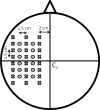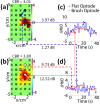Improving optical contact for functional near‑infrared brain spectroscopy and imaging with brush optodes
- PMID: 22567582
- PMCID: PMC3342194
- DOI: 10.1364/BOE.3.000878
Improving optical contact for functional near‑infrared brain spectroscopy and imaging with brush optodes
Abstract
A novel brush optode was designed and demonstrated to overcome poor optical contact with the scalp that can occur during functional near infrared spectroscopy (fNIRS) and imaging due to light obstruction by hair. The brush optodes were implemented as an attachment to existing commercial flat-faced (conventional) fiber bundle optodes. The goal was that the brush optodes would thread through hair and improve optical contact on subjects with dense hair. Simulations and experiments were performed to assess the magnitude of these improvements. FNIRS measurements on 17 subjects with varying hair colors (blonde, brown, and black) and hair densities (0-2.96 hairs/mm(2)) were performed during a finger tapping protocol for both flat and brush optodes. In addition to reaching a study success rate of almost 100% when using the brush optode extensions, the measurement setup times were reduced by a factor of three. Furthermore, the brush optodes enabled improvements in the activation signal-to-noise ratio (SNR) by up to a factor of ten as well as significant (p < 0.05) increases in the detected area of activation (dAoA). The measured improvements in SNR were matched by Monte Carlo (MC) simulations of photon propagation through scalp and hair. In addition, an analytical model was derived to mathematically estimate the observed light power losses due to different hair colors and hair densities. Interestingly, the derived analytical formula produced excellent estimates of the experimental data and MC simulation results despite several simplifying assumptions. The analytical model enables researchers to readily estimate the light power losses due to obstruction by hair for both flat-faced fiber bundles and individual fibers for a given subject.
Keywords: (170.2655) Functional monitoring and imaging; (170.3880) Medical and biological imaging; (300.6340) Spectroscopy, infrared.
Figures











Similar articles
-
PHOEBE: a method for real time mapping of optodes-scalp coupling in functional near-infrared spectroscopy.Biomed Opt Express. 2016 Nov 15;7(12):5104-5119. doi: 10.1364/BOE.7.005104. eCollection 2016 Dec 1. Biomed Opt Express. 2016. PMID: 28018728 Free PMC article.
-
fNIRS Optodes' Location Decider (fOLD): a toolbox for probe arrangement guided by brain regions-of-interest.Sci Rep. 2018 Feb 20;8(1):3341. doi: 10.1038/s41598-018-21716-z. Sci Rep. 2018. PMID: 29463928 Free PMC article.
-
Optimal positioning of optodes on the scalp for personalized functional near-infrared spectroscopy investigations.J Neurosci Methods. 2018 Nov 1;309:91-108. doi: 10.1016/j.jneumeth.2018.08.006. Epub 2018 Aug 11. J Neurosci Methods. 2018. PMID: 30107210
-
Optical sensors for clinical monitoring.Acta Anaesthesiol Scand Suppl. 1995;104:37-54. doi: 10.1111/j.1399-6576.1995.tb04254.x. Acta Anaesthesiol Scand Suppl. 1995. PMID: 7660749 Review.
-
Optical sensors (optodes) for multiparameter chemical imaging: classification, challenges, and prospects.Analyst. 2023 Dec 18;149(1):29-45. doi: 10.1039/d3an01661g. Analyst. 2023. PMID: 37975528 Review.
Cited by
-
Near-Infrared Spectroscopy as a Tool for Marine Mammal Research and Care.Front Physiol. 2022 Jan 17;12:816701. doi: 10.3389/fphys.2021.816701. eCollection 2021. Front Physiol. 2022. PMID: 35111080 Free PMC article.
-
Clinical Utility of Functional Near-Infrared Spectroscopy for Assessment and Prediction of Suicidality: A Systematic Review.Front Psychiatry. 2021 Oct 1;12:716276. doi: 10.3389/fpsyt.2021.716276. eCollection 2021. Front Psychiatry. 2021. PMID: 34658955 Free PMC article.
-
A functional near-infrared spectroscopic investigation of speech production during reading.Hum Brain Mapp. 2018 Mar;39(3):1428-1437. doi: 10.1002/hbm.23932. Epub 2017 Dec 19. Hum Brain Mapp. 2018. PMID: 29266623 Free PMC article.
-
Effect of motion artifacts and their correction on near-infrared spectroscopy oscillation data: a study in healthy subjects and stroke patients.J Biomed Opt. 2015 May;20(5):56011. doi: 10.1117/1.JBO.20.5.056011. J Biomed Opt. 2015. PMID: 26018790 Free PMC article.
-
Demographic reporting and phenotypic exclusion in fNIRS.Front Neurosci. 2023 May 9;17:1086208. doi: 10.3389/fnins.2023.1086208. eCollection 2023. Front Neurosci. 2023. PMID: 37229429 Free PMC article.
References
Grants and funding
LinkOut - more resources
Full Text Sources
Other Literature Sources
